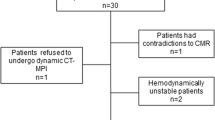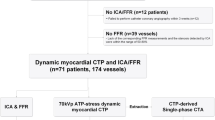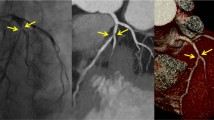Abstract
To prospectively compare the diagnostic performance of low-dose computed tomography coronary angiography (CTCA) and cardiac magnetic resonance imaging (CMR) and combinations thereof for the diagnosis of significant coronary stenoses. Forty-three consecutive patients with known or suspected coronary artery disease underwent catheter coronary angiography (CA), dual-source CTCA with prospective electrocardiography-gating, and cardiac CMR (1.5 Tesla). The following tests were analyzed: (1) low-dose CTCA, (2) adenosine stress-rest perfusion-CMR, (3) late gadolinium enhancement (LGE), (4) perfusion-CMR and LGE, (5) low-dose CTCA combined with perfusion-CMR, (5) low-dose CTCA combined with late gadolinium-enhancement, (6) low-dose CTCA combined with perfusion-CMR and LGE. CA served as the standard of reference. CA revealed >50% diameter stenoses in 68/129 (57.7%) coronary arteries in 29/43 (70%) patients. In the patient-based analysis, sensitivity, specificity, NPV and PPV of low-dose CTCA for the detection of significant stenoses were 100, 92.9, 100 and 96.7%, respectively. For perfusion-CMR and LGE, sensitivity, specificity, NPV, PPV, and accuracy were 89.7, 100, 82.4, and 100%, respectively. In the artery-based analysis, sensitivity and NPV of low-dose CTCA was significantly (P < 0.05) higher than that of perfusion-CMR and LGE. All combinations of low-dose CTCA and perfusion-CMR and/or LGE did not improve the diagnostic performance when compared to low-dose CTCA alone. Taking CA as standard of reference, low-dose CTCA outperforms CMR with regard to sensitivity and NPV, whereas CMR is more specific and has a higher PPV than low-dose CTCA.



Similar content being viewed by others
References
Brunken RC (2009) 2008 Nuclear cardiology review. J Nucl Med 50:29N–30N. doi:50/2/29N
Schwitter J, Wacker CM, van Rossum AC, Lombardi M, Al-Saadi N, Ahlstrom H, Dill T, Larsson HB, Flamm SD, Marquardt M, Johansson L (2008) MR-IMPACT: comparison of perfusion-cardiac magnetic resonance with single-photon emission computed tomography for the detection of coronary artery disease in a multicentre, multivendor, randomized trial. Eur Heart J 29:480–489
Leschka S, Alkadhi H, Plass A, Desbiolles L, Grunenfelder J, Marincek B, Wildermuth S (2005) Accuracy of MSCT coronary angiography with 64-slice technology: first experience. Eur Heart J 26:1482–1487
Nikolaou K, Knez A, Rist C, Wintersperger BJ, Leber A, Johnson T, Reiser MF, Becker CR (2006) Accuracy of 64-MDCT in the diagnosis of ischemic heart disease. AJR Am J Roentgenol 187:111–117
Hsieh J, Londt J, Vass M, Li J, Tang X, Okerlund D (2006) Step-and-shoot data acquisition and reconstruction for cardiac x-ray computed tomography. Med Phys 33:4236–4248
Scheffel H, Alkadhi H, Leschka S, Plass A, Desbiolles L, Guber I, Krauss T, Gruenenfelder J, Genoni M, Luescher TF, Marincek B, Stolzmann P (2008) Low-dose CT coronary angiography in the step-and-shoot mode: diagnostic performance. Heart 94:1132–1137
Alkadhi H (2009) Radiation dose of cardiac CT—what is the evidence? Eur Radiol 19:1311–1315. doi:10.1007/s00330-009-1312-y
Giang T, Nanz D, Coulden R, Friedrich M, Graves M, Alsaadi N, Luscher T, Vonschulthess G, Schwitter J (2004) Detection of coronary artery disease by magnetic resonance myocardial perfusion imaging with various contrast medium doses: first european multi-centre experience. Eur Heart J 25:1657–1665. doi:10.1016/j.ehj.2004.06.037
Schwitter J, Nanz D, Kneifel S, Bertschinger K, Büchi M, Knüsel PR, Marincek B, Lüscher TF, von Schulthess GK (2001) Assessment of myocardial perfusion in coronary artery disease by magnetic resonance: a comparison with positron emission tomography and coronary angiography. Circulation 103:2230–2235
Stolzmann P, Donati OF, Scheffel H, Azemaj N, Baumueller S, Plass A, Kozerke S, Leschka S, Grünenfelder J, Boesiger P, Marincek B, Alkadhi H (2010) Lowdose CT coronary angiography for the prediction of myocardial ischemia. Eur Radioll 20:56–64. doi:10.1007/s00330-009-1536-x
Gutstein A, Wolak A, Lee C, Dey D, Ohba M, Suzuki Y, Cheng V, Gransar H, Suzuki S, Friedman J, Thomson LE, Hayes S, Pimentel R, Paz W, Slomka P, Berman DS (2008) Predicting success of prospective and retrospective gating with dual-source coronary computed tomography angiography: development of selection criteria and initial experience. J Cardiovasc Comput Tomogr 2:81–90. doi:S1934-5925(08)00003-8
Austen WG, Edwards JE, Frye RL, Gensini GG, Gott VL, Griffith LS, McGoon DC, Murphy ML, Roe BB (1975) A reporting system on patients evaluated for coronary artery disease. Report of the Ad Hoc Committee for Grading of Coronary Artery Disease, Council on Cardiovascular Surgery, American Heart Association. Circulation 51:5–40
Cerqueira MD, Weissman NJ, Dilsizian V, Jacobs AK, Kaul S, Laskey WK, Pennell DJ, Rumberger JA, Ryan T, Verani MS (2002) Standardized myocardial segmentation and nomenclature for tomographic imaging of the heart. A statement for healthcare professionals from the Cardiac Imaging Committee of the Council on Clinical Cardiology of the American Heart Association. Int J Cardiovasc Imaging 18:539–542
Plein S, Ryf S, Schwitter J, Radjenovic A, Boesiger P, Kozerke S (2007) Dynamic contrast-enhanced myocardial perfusion MRI accelerated with k-t sense. Magn Reson Med 58:777–785. doi:10.1002/(ISSN)1522-2594
Gebker R, Jahnke C, Paetsch I, Schnackenburg B, Kozerke S, Bornstedt A, Fleck E, Nagel E (2007) MR myocardial perfusion imaging with k-space and time broad-use linear acquisition speed-up technique: feasibility study. Radiology 245:863–871. doi:10.1148/radiol.2453061701
Plein S, Schwitter J, Suerder D, Greenwood JP, Boesiger P, Kozerke S (2008) k-Space and time sensitivity encoding-accelerated myocardial perfusion MR imaging at 3.0 T: comparison with 1.5 T. Radiology 249:493–500. doi:10.1148/radiol.2492080017
Klem I, Heitner JF, Shah DJ, Sketch MH Jr, Behar V, Weinsaft J, Cawley P, Parker M, Elliott M, Judd RM, Kim RJ (2006) Improved detection of coronary artery disease by stress perfusion cardiovascular magnetic resonance with the use of delayed enhancement infarction imaging. J Am Coll Cardiol 47:1630–1638. doi:S0735-1097(06)00174-4
Herzog BA, Husmann L, Landmesser U, Kaufmann PA (2009) Low-dose computed tomography coronary angiography and myocardial perfusion imaging: cardiac hybrid imaging below 3 mSv. Eur Heart J 30:644. doi:ehn490
Baumuller S, Leschka S, Desbiolles L, Stolzmann P, Scheffel H, Seifert B, Marincek B, Alkadhi H (2009) Dual-source versus 64-Section CT Coronary Angiography at lower heart rates: comparison of accuracy and radiation dose. Radiology 253:56–64
Stolzmann P, Leschka S, Scheffel H, Krauss T, Desbiolles L, Plass A, Genoni M, Flohr TG, Wildermuth S, Marincek B, Alkadhi H (2008) Dual-source CT in step-and-shoot mode: noninvasive coronary angiography with low radiation dose. Radiology 249:71–80. doi:10.1148/radiol.2483072032
Stolzmann P, Scheffel H, Leschka S, Plass A, Baumuller S, Marincek B, Alkadhi H (2008) Influence of calcifications on diagnostic accuracy of coronary CT angiography using prospective ECG triggering. AJR Am J Roentgenol 191:1684–1689
Choudhury L, Mahrholdt H, Wagner A, Choi KM, Elliott MD, Klocke FJ, Bonow RO, Judd RM, Kim RJ (2002) Myocardial scarring in asymptomatic or mildly symptomatic patients with hypertrophic cardiomyopathy. J Am Coll Cardiol 40:2156–2164. doi:S0735109702026025
McCrohon JA, Moon JC, Prasad SK, McKenna WJ, Lorenz CH, Coats AJ, Pennell DJ (2003) Differentiation of heart failure related to dilated cardiomyopathy and coronary artery disease using gadolinium-enhanced cardiovascular magnetic resonance. Circulation 108:54–59. doi:10.1161/01.CIR.0000078641.19365.4C
Steel K, Broderick R, Gandla V, Larose E, Resnic F, Jerosch-Herold M, Brown KA, Kwong RY (2009) Complementary prognostic values of stress myocardial perfusion and late gadolinium enhancement imaging by cardiac magnetic resonance in patients with known or suspected coronary artery disease. Circulation 120:1390–1400. doi:CIRCULATIONAHA.108.812503
Nandalur KR, Dwamena BA, Choudhri AF, Nandalur MR, Carlos RC (2007) Diagnostic performance of stress cardiac magnetic resonance imaging in the detection of coronary artery disease: a meta-analysis. J Am Coll Cardiol 50:1343–1353. doi:10.1016/j.jacc.2007.06.030
Setser RM, O’Donnell TP, Smedira NG, Sabik JF, Halliburton SS, Stillman A, White RD (2005) Coregistered MR imaging myocardial viability maps and multi-detector row CT coronary angiography displays for surgical revascularization planning: initial experience. Radiology 237:465–473. doi:10.1148/radiol.2372040236
Meijboom WB, van Mieghem CA, Mollet NR, Pugliese F, Weustink AC, van Pelt N, Cademartiri F, Nieman K, Boersma E, de Jaegere P, Krestin GP, de Feyter PJ (2007) 64-slice computed tomography coronary angiography in patients with high, intermediate, or low pretest probability of significant coronary artery disease. J Am Coll Cardiol 50:1469–1475. doi:S0735-1097(07)02245-0
Watkins S, McGeoch R, Lyne J, Steedman T, Good R, McLaughlin MJ, Cunningham T, Bezlyak V, Ford I, Dargie HJ, Oldroyd KG (2009) Validation of magnetic resonance myocardial perfusion imaging with fractional flow reserve for the detection of significant coronary heart disease. Circulation 120:2207–2213. doi:CIRCULATIONAHA.109.872358
Wolff SD, Schwitter J, Coulden R, Friedrich MG, Bluemke DA, Biederman RW, Martin ET, Lansky AJ, Kashanian F, Foo TK, Licato PE, Comeau CR (2004) Myocardial first-pass perfusion magnetic resonance imaging: a multicenter dose-ranging study. Circulation 110:732–737. doi:10.1161/01.CIR.0000138106.84335.62
Di Bella EV, Parker DL, Sinusas AJ (2005) On the dark rim artifact in dynamic contrast-enhanced MRI myocardial perfusion studies. Magn Reson Med 54:1295–1299. doi:10.1002/mrm.20666
Acknowledgments
This research has been supported by the National Center of Competence in Research, Computer Aided and Image Guided Medical Interventions of the Swiss National Science Foundation, Switzerland.
Author information
Authors and Affiliations
Corresponding author
Rights and permissions
About this article
Cite this article
Scheffel, H., Stolzmann, P., Alkadhi, H. et al. Low-dose CT and cardiac MR for the diagnosis of coronary artery disease: accuracy of single and combined approaches. Int J Cardiovasc Imaging 26, 579–590 (2010). https://doi.org/10.1007/s10554-010-9595-2
Received:
Accepted:
Published:
Issue Date:
DOI: https://doi.org/10.1007/s10554-010-9595-2




